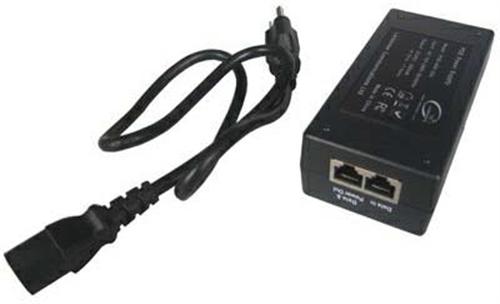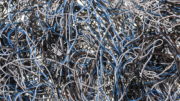Power over Ethernet, just three simple words that say a lot. It seems like a pretty easy subject to discuss, yet there’s a lot about it that isn’t clear. When the time came for me to write an article on power over Ethernet, I found myself actually trying to decide what to write about since I could go on for thousands of words.
The very basic definition of power over Ethernet
The same standard that governs all other Ethernet connectivity, IEEE 802.3, allows for a pair of wires to be used to carry up to 25 watts of power on the same cable as you use for data. It’s a pretty smooth way to power something as long as you don’t need a lot of electricity.
Power over Ethernet usually uses an injector like the one you see above to add power from a wall socket. Some advanced network switches also have the ability to put power on the line but the average home user won’t generally see those.
25 watts isn’t enough to power a computer or printer, so when would you use power over Ethernet? There are two common scenarios:
Security cameras and other surveillance equipment
In security and surveillance applications, PoE (as the knowledgeable folks call it) is used for cameras,because it means running fewer wires and that way every camera doesn’t need its own wall outlet. This cuts down on installation time and cost. since practically every new security system uses internet-protocol-based cameras, adding power to the line is pretty much a no-brainer.
Networking applications
In networking applications like creating a large wireless network, PoE is used for much the same reason. If you want to give Wi-Fi to a large number of people in an office, you use access points. Often times these access points are mounted to a ceiling and using PoE means that it’s easier to get power to these points, because commercial codes for electrical power often mean costly plenum-rated cables and steel conduits. A single cable rather than multiple cables can mean a savings of thousands of dollars.
In a nutshell
Simply put, use PoE for any case where you’re running an Ethernet cable anyway and you don’t want to run a power cable. Just be sure that the devices you’re using are designed for PoE use. Plugging a powered Ethernet cable into a device that’s not designed to accept it could damage the device. There are passive PoE splitters as well. They will allow you to use Ethernet cable to get the power to the device then safely split it off. In a case like that, there is another consideration. You would have to be sure that you can provide the right wattage to the device you’re powering, though, and that may be a little harder than you think.
You can find the best selection of power over Ethernet products when you shop at Solid Signal. In many cases, an injector from one company will work with products from another. You should always check specifications to be sure. Specifically check the voltage and wattage requirements of anything you need to power. If you don’t know exactly what you’re looking for, you can get help from an expert. Call Solid Signal at 888-233-7563. We’re here in our Michigan corporate offices during East Coast business hours. If it’s after hours, fill out the form below. We’ll get back to you quickly!





